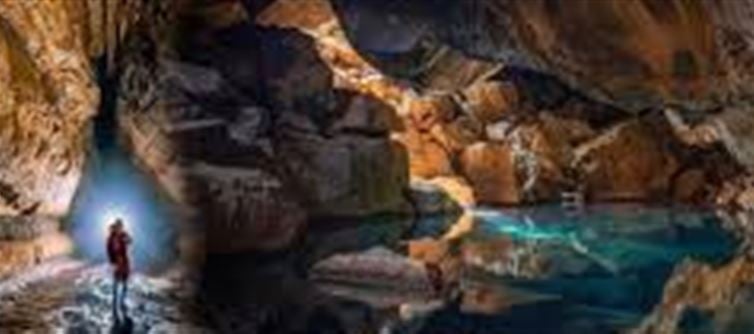
India is home to a treasure trove of ancient caves that span thousands of years, showcasing the country’s rich cultural, historical, and natural heritage. These caves are not only geological wonders but also carry deep spiritual and archaeological significance. Some of these caves date back to the Stone Age, while others are linked to ancient Buddhist, Jain, and Hindu traditions. Below is a list of the 10 largest caves in India, each with its unique charm and significance.
1. Elephanta Caves (Maharashtra)
Located near Mumbai, the Elephanta Caves are renowned for their rock-cut architecture and sculptural artwork dedicated to Hindu deities. The largest cave is the Maheshamurti cave, which houses a massive sculpture of Lord Shiva. These caves date back to the 5th-8th century and are UNESCO World heritage sites.
· Highlights: Intricate rock carvings, Shiva’s 3-headed sculpture, historical significance.
· Area: 60,000 sq. ft.
2. Ajanta Caves (Maharashtra)
The Ajanta Caves are a group of 30 rock-cut Buddhist caves that were constructed between the 2nd century BCE and 480 CE. These caves are famous for their exquisite paintings and sculptures that depict the life of Buddha, Buddhist deities, and various Jataka tales.
· Highlights: Ancient frescoes, rock-cut temples, UNESCO World heritage site.
· Area: Approximately 76,000 sq. ft.
3. Ellora Caves (Maharashtra)
Located near Aurangabad, the Ellora Caves are one of the largest cave complexes in India. They feature 34 caves that were created between the 5th and 10th centuries, representing Buddhist, Hindu, and Jain traditions. The Kailasa Temple, a single monolithic structure, is one of the most impressive caves here.
· Highlights: Kailasa Temple, a blend of Hindu, Jain, and Buddhist rock-cut temples, intricate carvings.
· Area: 2 million sq. ft.
4. Badami Caves (Karnataka)
The Badami Caves are a series of 4 rock-cut temples carved into the cliffs of Badami. These caves date back to the 6th century and represent a blend of Hindu, Jain, and Buddhist rock architecture. The caves are famous for their beautiful sculptures of gods and goddesses, especially the large sculptures of Vishnu, Shiva, and Jain Tirthankaras.
· Highlights: Stunning carvings, rock-cut temples, ancient sculptures.
· Area: 18,000 sq. ft.
5. Borra Caves (Andhra Pradesh)
The Borra Caves are limestone caves formed by the erosion of the region’s soft rock. These caves are located in the Ananthagiri hills of Andhra Pradesh. The caves are famous for their stalactites and stalagmites formations, and some of the caves have been used for religious purposes.
· Highlights: Stalactites and stalagmites formations, natural beauty.
· Area: 35,000 sq. ft.
6. Meghalaya Caves (Meghalaya)
The state of Meghalaya in the northeastern part of india is home to some of the largest and most fascinating caves, including the Siju Caves, Mawsmai Caves, and Liat Prah Cave. These caves are known for their stunning limestone formations and rich biodiversity.
· Highlights: Limestone formations, rare cave-dwelling species, picturesque surroundings.
· Area: Varies; some of the caves stretch for several kilometers.
7. Khandagiri and udayagiri Caves (Odisha)
Located near Bhubaneswar, the Khandagiri and udayagiri Caves are ancient Jain caves dating back to the 2nd century BCE. The caves are carved out of sandstone and feature detailed sculptures depicting the lives of Jain monks and their teachings.
· Highlights: Jain caves, inscriptions, architectural beauty.
· Area: Approx. 30,000 sq. ft.
8. Tirumala Caves (Andhra Pradesh)
The Tirumala Caves, located in the Tirupati region, are famous for their ancient rock formations and religious significance. The caves are situated at the base of the Tirumala Hills and have been a place of worship for centuries.
· Highlights: Ancient rock formations, religious importance, historical caves.
· Area: 12,000 sq. ft.
9. Elephant Caves (Rajasthan)
The Elephant Caves are located in the Aravalli Hills of Rajasthan, near the town of Udaipur. These caves are ancient rock-cut temples, many of which are dedicated to Lord Shiva. The caves are also famous for their unique natural features, including an elephant-shaped formation at the entrance.
· Highlights: Elephant-shaped rock formations, ancient temples.
· Area: 25,000 sq. ft.
10. Mawsmai Caves (Meghalaya)
Located in the Cherrapunji region of meghalaya, the Mawsmai Caves are famous for their limestone formations, particularly the long network of natural tunnels and chambers. The caves are relatively accessible to tourists and are known for their scenic surroundings.
· Highlights: Limestone formations, spectacular natural tunnels.
· Area: 20,000 sq. ft.
Conclusion
India’s caves are not just geological marvels but also gateways to the country's rich cultural and historical past. These caves, ranging from the Buddhist Ajanta and Ellora caves to the Jain temples of Khandagiri and Udayagiri, offer a deep insight into ancient architecture, religious practices, and natural beauty. Whether you’re a history buff, nature lover, or adventure seeker, India’s caves are waiting to be explored.
So, plan your next adventure to these awe-inspiring natural wonders and immerse yourself in the mysteries they hold!
Disclaimer:
The views and opinions expressed in this article are those of the author and do not necessarily reflect the official policy or position of any agency, organization, employer, or company. All information provided is for general informational purposes only. While every effort has been made to ensure accuracy, we make no representations or warranties of any kind, express or implied, about the completeness, reliability, or suitability of the information contained herein. Readers are advised to verify facts and seek professional advice where necessary. Any reliance placed on such information is strictly at the reader’s own risk..jpg)




 click and follow Indiaherald WhatsApp channel
click and follow Indiaherald WhatsApp channel